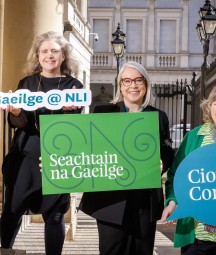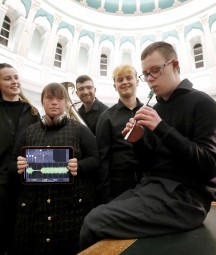The exhibition captures the social, cultural and technological changes that have taken place across Ireland from the middle of the 19th century up to the turn of this century, and has a number of photos charting Dublin life.
The broad exhibition includes images featuring women in the 1860s selling refreshments in Killarney and a passing steam train in Clones, Co Monaghan in 1959 are some of the photographs which give a glimpse into both Irish history and the evolution of photography. The exhibition comprises 50 photographs taken between 1858 – 2001, representing the age of analogue photography in Ireland. Photographs on display include early forms such as salt paper print and stereo-pair up to more contemporary photography.
One of the featured images from Dublin includes ‘Ballymun flats, Dublin City, 1969, from the Wiltshire collection’. In the photo we can see a high rise building, which was seen as a solution to the overcrowding in old houses in the city centre at the time. The towers were completed in 1967, but the design layout was criticised as anti-social and the area developed serious problems with drug dealing and associated issues. The flats were demolished between 2004 and 2015. These children were identified on NLI’s Flickr Commons as Sandra Corcoran, second left, and Marie Knowles, right, and the dark haired girls are sisters, Sandra and Caroline Kilbride.
Commenting, Acting Head of Exhibitions, Learning and Programming at the NLI and curator of this exhibition, Sara Smyth said:
“What’s collected today becomes history tomorrow. As Ireland’s memory-keeper, the NLI continues to collect and share a vibrant national collection that documents historical and contemporary life on the island of Ireland. The NLI houses over five million photographs, which are a visual record of the history and culture of Ireland.
“The exhibition will run until 2025 and phase one will feature framed photographs from 20 of our most popular collections. The images selected speak to the diversity of Ireland, with photographs representing almost every county, North and South of the Border.
“We highlight working-class and middle-class communities; women, who usually appear less often than men in history telling; and we juxtaposition rural communities alongside their urban counterparts. Themes, such as climate change and transport, are also addressed.”
Join the exhibition’s curator, Sara Smyth, for a free tour of the exhibition over the Summer, with a monthly tour on Thursday 20th July and Thursday 17th August from 1.00-1.40pm, no booking required.
If you are in Dublin with friends, young kids or family, you can pop into the free and accessible People and Places exhibition 10am–4pm Monday to Sunday, with last admission 3.30pm.
ENDS


